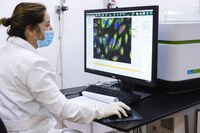Repurposing of tamoxifen ameliorates CLN3 and CLN7 disease phenotype
Authors: Chiara Soldati, Irene Lopez-Fabuel, Luca G Wanderling, Marina Garcia-Macia, Jlenia Monfregola, Alessandra Esposito, Gennaro Napolitano, Marta Guevara-Ferrer, Anna Scotto Rosato, Einar K Krogsaete, Dominik Paquet,
Christian M Grimm, Sandro Montefusco, Thomas Braulke, Stephan Storch, Sara E Mole, Maria A De Matteis, Andrea Ballabio, Julio L Sampaio, Tristan McKay, Ludger Johannes, Juan P Bolaños, Diego L Medina
Year: 2021
Sources: EMBO Molecular Medicine
Abstract:
Batten diseases (BDs) are a group of lysosomal storage disorders characterized by seizure, visual loss, and cognitive and motor deterioration. We discovered increased levels of globotriaosylceramide (Gb3) in cellular and murine models of CLN3 and CLN7 diseases and used fluorescent-conjugated bacterial toxins to label Gb3 to develop a cell-based high content imaging (HCI) screening assay for the repurposing of FDA-approved compounds able to reduce this accumulation within BD cells. We found that tamoxifen reduced the lysosomal accumulation of Gb3 in CLN3 and CLN7 cell models, including neuronal progenitor cells (NPCs) from CLN7 patient-derived induced pluripotent stem cells (iPSC). Here, tamoxifen exerts its action through a mechanism that involves activation of the transcription factor EB (TFEB), a master gene of lysosomal function and autophagy. In vivoadministration of tamoxifen to the CLN7Δex2 mouse model reduced the accumulation of Gb3 and SCMAS, decreased neuroinflammation, and improved motor coordination. These data strongly suggest that tamoxifen may be a suitable drug to treat some types of Batten disease.
Category: journals

